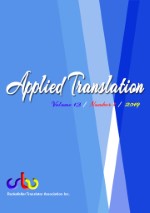The translation applied in intersemiotic study
Keywords:
drama, iconic, intersemiotic, theatre, translationAbstract
The present research was a corpus-based descriptive qualitative content analysis of Shakespeare’s Macbeth, based on Peirce’s intersemiotic model. The drama was translated interlingually from English to Farsi and intersemiotically by Servati for stage performance. Regarding the first research question (Which signs (iconical, indexical, or symbolic) are more applicable to semiotic analysis of Macbeth performance?), the results of the analysis show that the intersemiotic translation of drama was not successful in transferring some iconic signs from page to stage. Iconic signs are more susceptible to inappropriate intersemiotic translation than indexical signs and symbolic signs. Considering Servati’s adaptation, it can be judged that other aspects, namely, secondness and thirdness, are more manageable when translating drama into a stage performance. This finding, in this case study, contradicts the findings of some previous studies regarding the point that intersemiotic translation is a deeply iconic dependent process. The contradictory results may be related to cultural differences and different cultural signs of the two involved languages.
References
Anderson, J., & Lotman, M. K. (2018). Intrasemiotic translation in the emulations of ancient art: On the example of the collections of the University of Tartu Art Museum. Semiotica, 2018(222), 1-24. https://doi.org/10.1515/sem-2016-0118
Anttonen, P. (2014). Lost in Intersemiotic Translation?: The Problem of Context in Folk Narratives in the Archive. Arv: tidskrift för nordisk folkminnesforskning, 69, 153-170.
Arcos, R. (2015). Translation of the dress in advertising campaigns for the Arab culture: narratives, powers, ideologies. Procedia-Social and Behavioral Sciences, 212, 242-245. https://doi.org/10.1016/j.sbspro.2015.11.340
Chovanec, J. (2019). Multimodal storytelling in the news: Sequenced images as ideological scripts of othering. Discourse, Context & Media, 28, 8-18. https://doi.org/10.1016/j.dcm.2019.01.001
El-dali, H. M. (2011). Towards an understanding of the distinctive nature of translation studies. Journal of King Saud University-Languages and Translation, 23(1), 29-45. https://doi.org/10.1016/j.jksult.2010.01.001
Francesconi, S. (2017). Dynamic intersemiosis as a humour-enacting trigger in a tourist video. Visual Communication, 16(4), 395-425. https://doi.org/10.1177%2F1470357217716378
Guijarro, A. J. M. (2011). Engaging readers through language and pictures. A case study. Journal of Pragmatics, 43(12), 2982-2991. https://doi.org/10.1016/j.pragma.2011.05.012
Hassanabadi, F. M., & Heidari, M. (2014). The effect of intersemiotic translation on vocabulary learning. Procedia-Social and Behavioral Sciences, 98, 1165-1173. https://doi.org/10.1016/j.sbspro.2014.03.530
Hubackova, S., & Semradova, I. (2012). Translation propaedeutics with support of a virtual learning environment. Procedia-Social and Behavioral Sciences, 47, 444-448. https://doi.org/10.1016/j.sbspro.2012.06.678
Karczmarzyk, M., & Wasilewska, A. (2013). Art in the Eyes of Six-year-old Children. Children's Semantic Hypallages Regarding Paintings of Great Masters. Procedia-Social and Behavioral Sciences, 106, 485-494. https://doi.org/10.1016/j.sbspro.2013.12.054
Lebedeva, O. B. (2015). Russian literary process in the 1760-1770s: novel as a representative of interconnection of epistemic reproductive models. Procedia-Social and Behavioral Sciences, 200, 283-288. https://doi.org/10.1016/j.sbspro.2015.08.066
Leontovich, O. A. (2015). Word and image in search of each other: intersemiotic translation of narratives from an intercultural perspective. Procedia-Social and Behavioral Sciences, 200, 289-295. https://doi.org/10.1016/j.sbspro.2015.08.067
Maynard, S. K. (1999). A poetics of grammar: Playing with narrative perspectives and voices in Japanese and translation texts. Poetics, 26(3), 115-141. https://doi.org/10.1016/S0304-422X(98)00015-1
Mishankina, N. A., & Zheleznyakova, A. N. (2015). The problem of linguistic analysis of musical metaphors at lessons of Russian as a foreign language. Procedia-Social and Behavioral Sciences, 215, 316-321. https://doi.org/10.1016/j.sbspro.2015.11.640
Núñez, A. J. C. (2015). Multimodality and multi-sensoriality as basis for access to knowledge in translation: The case of audio description of colour and movement. Procedia-Social and Behavioral Sciences, 212, 210-217. https://doi.org/10.1016/j.sbspro.2015.11.335
Ovchinnikova, O. M., Frantsuzskaya, E. O., & Lutoshkina, O. S. (2015). Metaplan-based Development of Speaking Skills. Procedia-Social and Behavioral Sciences, 200, 624-630. https://doi.org/10.1016/j.sbspro.2015.08.049
Queiroz, J., & Atã, P. (2019). Intersemiotic translation, cognitive artefact, and creativity. Adaptation, 12(3), 298-314. https://doi.org/10.1093/adaptation/apz001
Salvato, L. (2015). An interdisciplinary approach to texts as a model for a truthful approach to reality. Procedia-Social and Behavioral Sciences, 174, 2875-2881. https://doi.org/10.1016/j.sbspro.2015.01.982
Shiryaeva, V., & Badea, G. L. (2014). Subtitling: the transfer of culture-specific words in a multidimensional translation. Procedia-Social and Behavioral Sciences, 149, 883-888. https://doi.org/10.1016/j.sbspro.2014.08.270
Simeone, L., Secundo, G., & Schiuma, G. (2017). Adopting a design approach to translate needs and interests of stakeholders in academic entrepreneurship: The MIT Senseable City Lab case. Technovation, 64, 58-67. https://doi.org/10.1016/j.technovation.2016.12.001
Smirnova, T. (2016). Synesthetic metaphors: aspects of intralingual and interlingual translation. Procedia-Social and Behavioral Sciences, 231, 40-45. https://doi.org/10.1016/j.sbspro.2016.09.069
Published
How to Cite
Issue
Section
Copyright (c) 2019 Collin Wilson

This work is licensed under a Creative Commons Attribution 4.0 International License.









